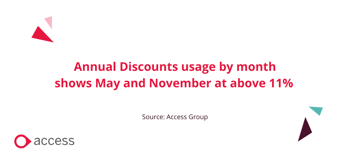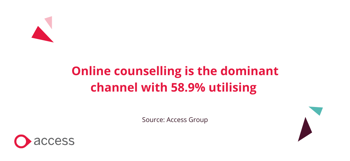Employee benefits statistics show benefits are the alternative to pay rises
Benefits in lieu of a salary increase can be an effective strategy to reward employees and recent employee benefits statistics from our report suggest that engagement with salary sacrifice schemes is trending positively in large organisations. With increased engagement, large organisations can save money whilst rewarding employees, leading to increased loyalty.
So, what do employee benefits statistics tell us about engagement and benefits as a viable alternative to pay rises? In this blog, we’ll detail findings from our report, what benefits employees value, and how that translates to savings in large businesses.
Contents
- Employee benefits statistics that show increased loyalty
- Employee benefits statistics that show a change in engagement
- Why benefits in lieu of salary increase work for large organisations
- Creating an environment employees love
- What benefits do employees value the most?
- The clear case for benefits over pay rises

Employee benefits statistics that show increased loyalty
Employee benefits statistics show that benefits increase loyalty.
- 75% of employees reported they’re more likely to stay with their employer because of their benefit program (Willis Towers Watson)
- 80% of employees would choose additional benefits over a pay raise (Harvard Business Review)
- 69% of employees report that they might choose one job over another if it offered better benefits (One Medical).
Employees who have and use a rewarding and engaging employee benefits package are less likely to switch employer because they might not get the same benefits at another company.
Furthermore, employees themselves can make savings through their employee benefits package that they might not get anywhere else. For example, through shopping cards employees can get discounts on their weekly shop.
Employee benefits can come in all forms, ranging from health and wellbeing benefits to childcare benefits to discounts on the latest tech. There’s a huge range of employee benefit schemes available that companies can roll out to their employees.

Employee benefits statistics that show a change in engagement
Our data reveals not just what benefits employers offer, but crucially, how employees engage with them. The success of an employee benefits scheme will tend to rely on the engagement. If you have a large and disparate employee base, it’s important to employ measures that increase the visibility of your offering. We will discuss how you can do so in this section.
Engagement with Employee Discounts
Employee discount schemes remain the cornerstone of many benefits packages, offering immediate, tangible value that helps stretch take-home pay. Our data reveals not just which discounts employees value most, but when and how they use them throughout the year. What are the key employee benefits statistics for Employee Discounts?
- Spring sales and festive seasons account for significant spikes
- Seasonal variance spreads to travel, with January – May peak
- Consistent year-round usage for supermarket discounts
- Annual Discounts usage by month shows May and November at above 11%
The advice for large businesses is to look to promote seasonally, aligning communications with purchasing patterns to maximise engagement. Emphasising flexibility and everyday value can be highly beneficial in demonstrating the overall value of your benefits package. An effective way to summarise the benefits you offer in lieu of salary increase is through Total Rewards Statements, helping your teams appreciate everything you offer them beyond pay.
Engagement with the Technology Scheme
The Technology Scheme continues to evolve beyond basic home computing needs, now encompassing everything from gaming equipment to home office setups and even home appliances.
- 10% increase in average application value demonstrating desire for premium tech
- Highest engagement (82.77% vs average) amongst the Transporation & Storage sector
- Manufacturing trending strongly with engagement at 69.06% vs average
The trends point to the scheme being successful across both traditionally professional and manufacturing/storage sector highlighting the importance of promoting for your whole workforce. Large organisations may have both subsets under their payroll and it’s important to demonstrate the benefits across the whole workforce fairly and equally. It can also be beneficial to tailor communications to demonstrate different benefits. This is where technology can help you tackle challenges, particularly in industries like manufacturing, with automated communications going out to your whole workforce. Industries like retail, manufacturing and hospitality already suffer from a wide range of HR tech challenges; we’ve addressed what these challenges are and solutions to them in our ‘Actionable guide to navigating HR tech challenges in retail, manufacturing and hospitality sectors’.
Engagement with the Bike Scheme
The Bike Scheme continues to be popular and evolve; the e-bike revolution and employees' growing investment in premium cycling as a lifestyle choice has seen a surge in application value.
- Average application value surging 42% year-on-year
- Employer NI savings as a result now average £142.11 per application
Growth leaders include Wholesale sector with a 127% increase in application value, followed by Personal Services at 93%
The Bike Scheme is a salary sacrifice scheme; as such, it’s popularity may keep growing, particularly with the recent National Insurance Contributions (NICs) rise from 13.8% to 15%. Salary sacrifice schemes offer an avenue for employees and employers to make significant savings on the contributions, with increased engagement leading to more savings. Our ‘NI Report’ details real world examples from our customer base on the savings that are possible by increasing engagement with salary sacrifice schemes.
The advice for large organisations would be to increase the scheme limits where possible and promote e-bikes actively to enhance green credentials linked with providing commuting alternatives.
Engagement with the Car Scheme
Car salary sacrifice schemes are increasing consistently in popularity along with increasing popularity with electric vehicles. Used strategically, the scheme can help employers increase NI savings, enhance their EVP and improve employee recruitment and retention.
- Public Sector engagement at 29.53%, 4x the average
- NI savings can be significant due to the higher order value
The Car Scheme can be more difficult to promote due to the complexities of the application, but as an organisation, you can promote the environmental benefits and putting a targeted launch in place. A targeted launch can be key to building initial usage and creating word-of-mouth across a large workforce, driving engagement.
Engagement with the Employee Assistance Programme (EAP)
The EAP is a commonly utilised, yet often underappreciated employee benefit. Changes in the way employees are using their EAP should be noted by employers, demonstrating a shift in delivery preferences of the 24/7, confidential support the scheme provides.
- Online counselling is the dominant channel with 58.9% utilising
- Face to face counselling up from 16.1% to 39% of sessions
These dramatic shifts indicate that employees value deeper therapeutic relationships and workplace mental health stigma continues to reduce. The support needs are also evolving, with significant financial pressures on people diversifying the support required. In respect to the surge and evolving needs, large organisations should continue to invest in promoting holistic support and EAP delivery. This can help ensure that all employees, no matter where they’re based, have access to the support they require.
Engagement with Holiday Trading
Holiday Trading schemes offer employees flexibility to purchase additional leave, reflecting changing attitudes toward work-life balance.
- Engagement averages out at 15% across industries
- Value growth of 27% in the Media industry
There is a trend of high engagement not correlating with high values, which can be improved through several strategies. Considering the cap to reflect what your whole workforce can afford and allowing for increased flexibility can promote more appetite for the scheme.

Why benefits in lieu of salary increase work for large organisations
Given the current economic climate and budget constraints, many large organisations are exploring alternatives to traditional pay rises. Employee benefits statistics consistently demonstrate that a well-structured benefits package can deliver comparable value to salary increases whilst offering additional advantages for both employers and employees.
Large organisations particularly benefit from this approach because they can leverage economies of scale to negotiate better rates with benefits providers, whilst also accessing more sophisticated reporting and analytics to measure engagement and ROI. The data shows that when employees understand the full value of their benefits package satisfaction levels can match or exceed those achieved through salary increases alone.
Furthermore, benefits offer tax advantages that salary increases don’t. Salary sacrifice schemes, for instance, reduce both employer and employee National Insurance contributions, creating a win-win scenario that stretches budgets further. With the recent NIC rise to 15%, these savings have become even more significant for large organisations managing substantial payrolls.
The key lies in ensuring high engagement levels across your workforce. Our data suggests that organisations achieving above-average engagement rates see the most success when positioning benefits as genuine salary alternatives rather than simple add-ons to existing compensation packages.
Creating an environment employees love
Companies like Google, Facebook and Microsoft prioritise creating an environment where employees feel appreciated and happy in their role. These environments create organic employee advocacy, and this can have wide ranging benefits for your large organisation. Our blog on employee advocacy details how you can build and improve a culture of advocacy.
Not all companies have the resources like they do to improve employee satisfaction, however companies of all sizes can introduce employee benefits which go a long way to not only increasing loyalty but creating a working environment that employees love.
A popular, happy working environment aided by a comprehensive employee benefits offering will not only improve retention but will make your company a more attractive proposition for talented new recruits.
In other words, imagine if you could offer a working environment that employees love, as well as a childcare scheme, bike to work scheme, shopping discounts at thousands of retailers and much, much more.
What benefits do employees value the most?
Clearly employee benefits statistics show employee benefits like the Bike to Work scheme are incredibly popular, but what we’ve seen lately is the emergence of flexible benefits and giving employees choice over which employee benefits they want to make use of.
While the list can vary hugely, benefits employees value the most include:
- Bike to Work scheme
- Holiday Trading
- Car Benefit scheme
- Employee Discounts
- Employee Assistance Programme
- Gym Scheme
- MotorSave
- Health Assessments
- Christmas Savings Club
plus many more.
There’s a lot of research out there on the best employee benefits for employees which we’ve covered before, but be sure to consider what’s right for your team based on demographics, wants and needs.
The clear case for benefits over pay rises
The employee benefits statistics presented here demonstrate that strategic benefits packages can exceed the value of traditional pay rises whilst delivering additional advantages for both employers and employees.
For large organisations, the mathematics become particularly attractive when considering dual savings potential – employees benefit from tax-efficient arrangements whilst employers leverage reduced National Insurance contributions, especially significant with rates now at 15%.
The key to success lies in thoughtful implementation and active promotion. Organisations achieving above-average engagement rates see the greatest returns, creating genuine win-win scenarios that traditional pay rises cannot match.
Understanding the full cost implications and potential savings is crucial for making informed decisions. For detailed guidance on budgeting and calculating ROI, explore our comprehensive analysis at how much do employee benefits cost.
When positioned correctly, employee benefits represent strategic investments in workforce satisfaction, retention, and organisational success.
How can employee benefits help your business?
We provide our huge range of employee benefits to over 2,000 businesses internationally. To find out how employee benefits could benefit your business and your employees, get in touch today and we’ll run you through all your options and provide a free demo of our market-leading employee benefits platform.
Latest employee benefits resources
Our employee benefits resources offer advice and guidance from industry experts on a range of topics, drawing on our years of experience and expertise in employee benefits.

 AU & NZ
AU & NZ
 SG
SG
 MY
MY
 US
US
 IE
IE





